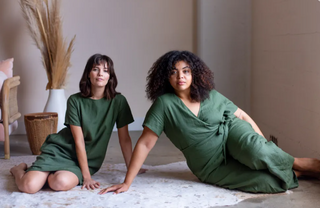Originally posted May 7, 2020.
It feels as if size inclusivity is the new hot button topic in the fashion space. Brands are touting their efforts when they release a product that’s size 14 with marketing campaigns targeted towards the plus-size community. But if you take one look at their size chart, it’s abundantly clear they are falling short in creating inclusive clothing.
Let’s look at the facts: more than 68% of American women wear a size 14 or above.
So why are brands applauding their efforts when they aren’t designing for the majority of American women?
Many brands hide behind the argument that expanding their size range is too costly for their small margins. There is no one who gets that more than me because Sotela is a small brand with small margins.
In 2019, despite not yet being profitable, we decided to double our size range in order to work towards true inclusivity. When we launched in 2016, we had three sizes, then expanded to four, and now we have ten sizes. Our current sizing ranges from 0-10, which in conventional sizing, translates to 0-30.
I won’t sugar coat it: expanding a brand’s size range is costly. Expanding sizing means that you are doubling the production process, needing two sets of fit models, patterns, and samples. However, it’s a worthwhile investment that pays off, both in terms of money and customer satisfaction, after you’ve designed a well-fitting piece that drapes beautifully on all bodies.
While finances, of course, play a major role in our ability to explore new concepts like this, so do our customers and our values. And ensuring that our customers can wear our designs at any size is of paramount importance to us.
Since we are a small brand, we’ve had the flexibility to learn from our mistakes in creating an inclusive size range. Although those mistakes were costly, it didn’t break us. On the other hand, because we are a small brand, we didn’t have the resources and cash flow bigger companies may have to double a size range. There will never be a perfect scenario to make your brand more inclusive. It has to be a choice the company wants to make.
We stand by the choice we made last year in creating a truly inclusive brand. With the availability of 30 sizes as well as different rise/inseam options, we are slowly creating tailored clothing for people. And, it’s paying off.
In an article I read last week, a slow fashion brand was quoted with only having 15% of sales in their plus size range.
After a year of creating, designing, and marketing inclusive clothing, I’ve seen an increase in sales in the plus-size range. In 2019, when I launched sizes 6-10, 12% of sales were in the plus-size range. I didn’t expect to have a significant increase in sales in those sizes because it takes time to build brand awareness and loyalty. Customers had to trust our clothing was designed for ALL bodies.
As of May 2020, our plus size sales have doubled. About 25% of our sales this year are in the plus-size range and the majority are within the past two months.
Our increase in plus-size sales can be attributed to the loyalty we’ve fostered with our community. We’ve clothed various types of bodies and promote it regularly on our social media channels. We don’t have a ‘type’ and we seek to show inclusivity on all fronts.
Inclusivity is at the core of everything we do. It’s a choice we made when we launched our company in 2016 and it drives all of our decisions to this day. Yes, there are obstacles for us like any other fashion brand, but we found that by prioritizing what was central to our values, we could make it happen.


